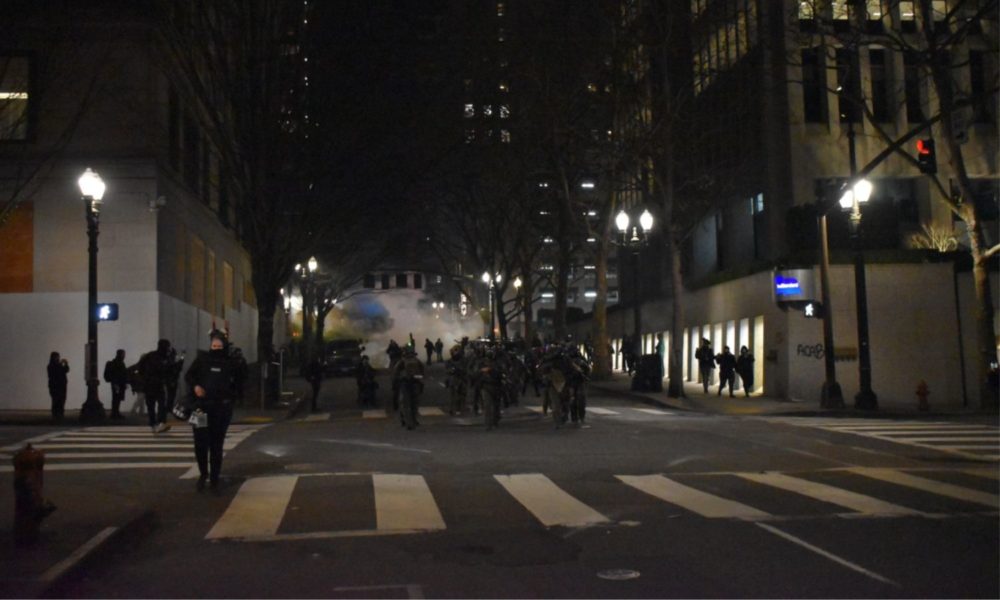Safariland—a chemical weapons company that boasts annual sales of over $850 million—has removed vital safety information from its hexachloroethane (HC) smoke grenades, each of which is capable of killing 10 people. The company is now selling HC grenades labeled with a health rating of 0, meaning “no risk to human health”—a dangerous falsehood about a deadly chemical.
Clearly, we cannot take Safariland’s word for it. In light of the US Congressional inquiry into health impacts of chemical weapons, lawmakers have an obligation to the public to seek independent scientific expertise on the dangers of these weapons.
What is hexachloroethane (HC) smoke?

Hexachloroethane-based (HC; C2Cl6) munitions smoke was developed in the early 1930s by the US Army’s Chemical Warfare Service and used heavily in World War II to obscure battalion movements and provide cover. By the end of the war, however, it was well-established that HC was poisonous, at least in part because HC smoke decomposes into tetrachloroethylene (C2Cl4), chlorine (Cl2), and other chlorinated carbon compounds.
HC is burned using zinc oxide and aluminum to produce gaseous zinc chloride (which generates the smoke), aluminum oxide, and various carbon products.
5 C2Cl6 + 15 ZnO + 6 Al → 15 ZnCl2 (g) + 3 Al2O3 + 6 CO + 4 C
The other concern regarding HC smoke is the release of heavy metal dust and fumes. The fire that generates the smoke is primarily based on zinc oxide (ZnO), which decomposes into oxygen (fuel for the fire) and vaporized zinc ions. Aluminum, iron, chromium, and lead are also included in the pyrotechnic mixture that burns at over 1400° C, resulting in additional gaseous metal byproducts. Finally, significant amounts of carbon monoxide (CO) are released by the burning chemicals. This concoction of deadly substances attack the central nervous, digestive, immune, and respiratory systems.
Extensive recognition of HC’s health impacts
By 1994, an official US Army Field Manual included a section titled Toxicity of HC Smoke, which stated:
Special care must be taken when using HC smoke… Wear a protective mask when exposed to HC smoke at all times. HC is toxic in high concentrations. Fatalities have occurred from HC smoke exposure during routine training where soldiers were not informed of the hazards.
In 1997, the National Academy of Sciences released a report on munitions smokes for the Defense Department. The report concluded that HC was highly toxic, carcinogenic, and lethal. These findings were not secret: they made it into US military guidelines on chemical weapons over a quarter century ago.
By 2012, the US Army was publicly talking about their research efforts to develop less dangerous and more effective screening smokes:
(HC) smoke compositions … are no longer produced because HC is highly toxic.
The Army’s decision to stop producing and using HC was well-founded. An analysis of hundreds of cases dating back to World War II showed that people exposed to HC experienced a range of symptoms, both immediate and long-term, including uncontrollable crying, difficulty breathing, coughing, chest pain, vomiting, nausea, irritation to mucous membranes (nose, lungs, stomach, intestines, etc.), rapid heartbeat, inflammation of skin and internal organs, chronic damage to the DNA of lung cells, and an average fatality rate of 14% across groups of individuals exposed to HC smoke.
In other words, HC is potent and painful. I know because I’ve experienced it firsthand. Multiple times.
Beyond its impacts on humans, HC is toxic to a range of organisms, including bats, evergreen and deciduous trees, salmon, aquatic invertebrates, and zebrafish. Of course, these are only the species for which exposure to HC has been studied; the chemical is likely dangerous to many more.
HC is toxic—so why is law enforcement using it on protesters?
Safariland’s subsidiary Defense Technology is the main manufacturer of HC grenades used by US law enforcement against 2020-21 racial justice protesters. During their deployment in Portland, Oregon from early-June 2020 to mid-May 2021, the US Department of Homeland Security (DHS) deployed at least 30 grenades into crowds of protesters, and into the waters of endangered salmon. And in advance of the 2020 Democratic National Convention, the Milwaukee Police Department requested 60 HC grenades.

Despite 75 years of research on the toxicity of HC, Defense Technology is selling it to law enforcement with health ratings of 0—meaning “no risk to human health”—for both their Large Style and Military-Style grenades.
Has Defense Technology come up with a safer version of HC?
No.
Well then, have they always claimed their HC grenades were safe?
Also no.
I have recovered four versions of the Safety Data Sheet for Defense Technology’s Military-Style HC grenade, from 1993, 2004, 2011, and 2015 (the current version). The 1993 and 2004 versions were subject to fewer requirements and typically lacked health ratings–the exception being the 2011 version that shows a Hazardous Materials Identification System health rating of 2 (moderate). That rating dropped to 0 in the 2015 version, despite no change in ingredients.
All four iterations did, however, include a section titled Hazardous Decomposition Products, which lists the dangerous substances that the grenades produce. This section has changed over time, with a lot less information in later versions.

The 1993 document clearly identifies HC’s main hazardous compounds: chlorinated vapors, metal oxides, and zinc chloride.
But this changes in the 2011 and 2015 (current) versions. The 2015 version, for example, lists a few dangerous substances, like carbon monoxide and sulfur oxides—but it’s missing many more, including chlorinated compounds, metal oxides, and zinc chloride. In other words, despite no change to the chemical reaction, the most common products are gone from these versions. They were replaced with generalized byproducts like sulfur oxides that are not unique to HC and that appear to be an attempt to justify the inappropriately low hazard ratings. Not a fluke, this pattern of erasure is also matched by their Large Style HC grenades.
“Chills, heavy chest… nausea”: HC in 1998 (and lessons for today)
Intriguingly, the timeline of the company’s erasures aligns with the settling in 2008 of a federal civil trial, in which a US Bureau of Prisons guard sued Defense Technology over a 1998 incident with an HC grenade in a training exercise. In that incident, an HC grenade was used in a training exercise instead of a flashbang grenade in a stairwell, when no one had gas masks on, and a large contingent of federal employees became violently ill.
Symptoms noted by the guards in 1998 included:
“…a great deal of coughing, … vomiting, difficulty breathing, and spitting up black sputum”
“spells of headaches and … ‘puking’”
“choking or spitting up”
“chills, heavy chest [lasted five days], and nausea … coughed up some black mucus”
The 1993 safety data sheet for HC is included in the After Incident Report filed by the Bureau of Prisons and submitted as evidence in the trial. The trial lasted a decade, during which Defense Technology released at least one other version, in 2004, which listed the main hazardous compounds as it did in 1993.
But the 2011 and 2015 versions—which did not list the most dangerous compounds—were both filed after the lawsuit was settled.
While the company had changed its safety sheets, it hadn’t changed the HC smoke. That smoke wreaked havoc on protesters in 2020-21, as it did for the victims of the 1998 HC incident—and in fact, the symptoms experienced by both groups of people are chillingly similar. Protesters and bystanders in Portland in 2020-21 exposed to HC reported that,
“My skin is burning and my chest hurts and I’m nauseous.”
“Just got f—-d up real bad…Felt like I was gonna puke.“
“I was stuck with my eyes closed choking against the wall.“
“I … would like this HC vice grip to get off my sternum.“
I do not know for how long Defense Technology (or any Safariland subsidiary) has sold HC grenades, but while the company’s safety sheets suggest HC is safer today, it’s as dangerous as it was two decades ago, and as it has always been.
Obfuscation of hazards provides grounds for use against people
The story that Defense Technology is telling retailers and law enforcement—that HC is a safe “crowd-control” chemical—is misleading and life-threatening. For example, the grenades are currently being marketed by prominent sellers on the West Coast as “designed specifically for outdoor use in crowd control situations,“ and “ideal for use to … route a crowd and … suitable for outdoor crowd control situations.“
To be abundantly clear, Hexachloroethane smoke is not a crowd-control chemical.
That has not stopped its use as such, however. DHS denied using HC, as they did not identify HC in public documents and dodged interview questions about it, despite substantial evidence documenting its use. The day after the most recent HC deployment by DHS in Portland (2021-03-11), I publicly questioned DHS Commander Luis Lopez about the agency’s use of the chemical. He replied, “I have no comment, Doctor.”
Perhaps DHS simply did not distinguish HC from other smokes, like Terephthalic Acid-based (TPA) smokes. Defense Technology has disingenuously named its TPA smoke grenades “SAF” (as in “safe”), despite their release of toxic levels of benzene and formaldehyde, for example. While it is dangerous, however, TPA is considerably less toxic than HC smoke, and a failure to distinguish them has the real potential to kill people.
In response to targeted questions from US Senator Wyden (OR), the new head of DHS finally acknowledged in July 2021 that they used HC in Portland during their protest response.
Congressional oversight
In June 2021, following a year of law enforcement’s use of chemical weapons against racial justice protestors, including in the nation’s capital, the US House of Representatives’ Oversight Subcommittees started an inquiry into the safety of these weapons. The Subcommittees requested internal documents and information from chemical weapons manufacturers—including Safariland—regarding the safety of their products. In their request, the representatives note that there is virtually no oversight of companies like Safariland that would ensure worker, user, and public safety.
It is in this vacuum that, following a federal lawsuit, Safariland scrubbed lethal compounds from their HC grenade safety data sheets.
If Safariland has no problem selling HC as safe for use on crowds, what else have they been willing to do?
I hope that these inquiries lead to the beginning of much stronger oversight for the manufacture, sale, and use of chemical weapons like HC. Lives are at stake.

